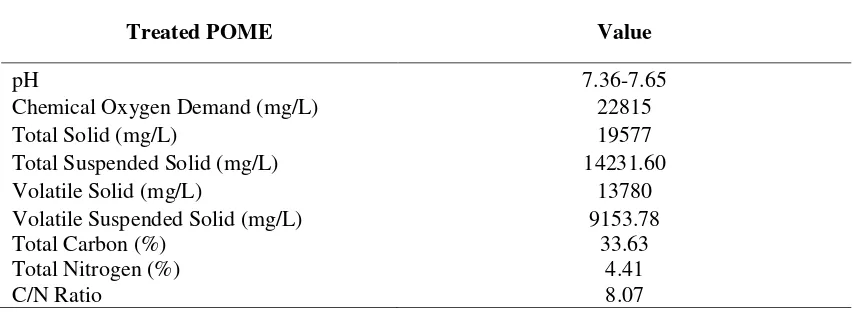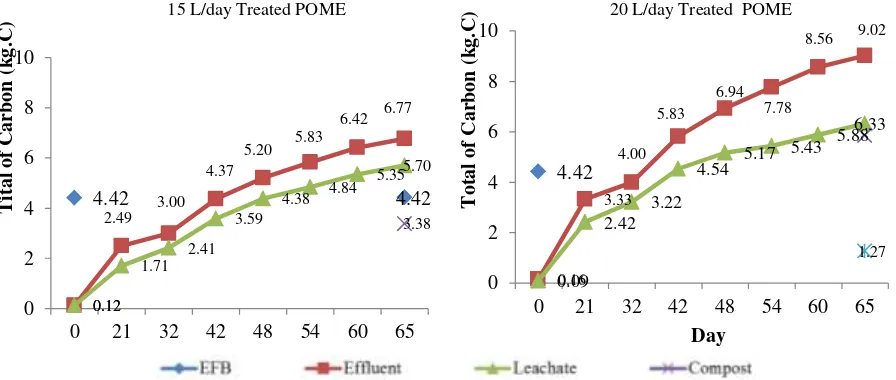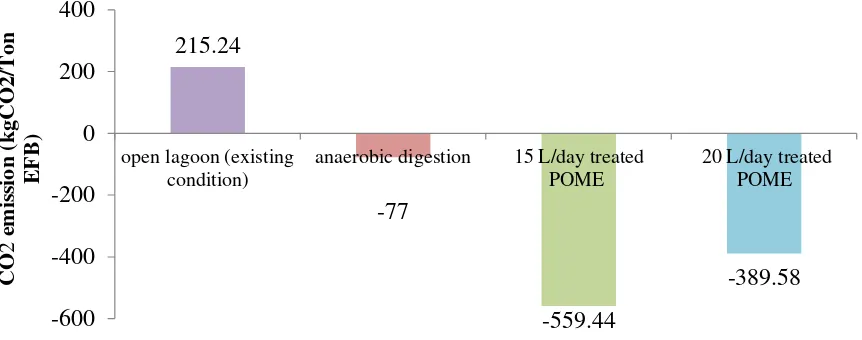IOP Conference Series: Earth and Environmental Science
PAPER • OPEN ACCESS
Performance evaluation of integrated solid-liquid
wastes treatment technology in palm oil industry
To cite this article: J R Amelia et al 2017 IOP Conf. Ser.: Earth Environ. Sci.65 012036
View the article online for updates and enhancements.
Related content
Polishing of POME by Chlorella sp. in suspended and immobilized system
F A Lahin, R Sarbatly and E Suali
-Performance Evaluation on Otto Engine Generator Using Gasoline and Biogas from Palm Oil Mill Effluent
Irvan, B Trisakti, T Husaini et al.
-A Survey on the Usage of Biomass Wastes from Palm Oil Mills on Sustainable Development of Oil Palm Plantations in Sarawak
K Y Phang and S W Lau
1234567890
International Conference on Biomass: Technology, Application, and Sustainable Development IOP Publishing IOP Conf. Series: Earth and Environmental Science 65 (2017) 012036 doi :10.1088/1755-1315/65/1/012036
Performance evaluation of integrated solid-liquid wastes
treatment technology in palm oil industry
J R Amelia
1, S Suprihatin
1, N S Indrasti
1, U Hasanudin
2and K Fujie
31Department of Agro-Industrial Technology, Bogor Agricultural University, Bogor,
Indonesia 2
Department of Agro-Industrial Technology, Faculty of Agriculture, University of Lampung, Bandar Lampung, Indonesia
3School of Environmental and Information Sciences, Yokohama National University,
Yokohama, Kanagawa Prefecture 240-8501,Japan
Email : fiamel2702@gmail.com
Abstract.
The oil palm industry significantly contributes to environmental degradation if without waste management properly. The newest alternative waste management that might be developed is by utilizing the effluent of POME anaerobic digestion with EFB through integrated anaerobic decomposition process. The aim of this research was to examine and evaluate the integrated solid-liquid waste treatment technology in the view point of greenhouse gasses emission, compost, and biogas production. POME was treated in anaerobic digester with loading rate about 1.65 gCOD/L/day. Treated POME with dosis of 15 and 20 L/day was sprayed to the anaerobic digester that was filled of 25 kg of EFB. The results of research showed that after 60 days, the C/N ratio of EFB decreased to 12.67 and 10.96 for dosis of treated POME 15 and 20 L/day, respectively. In case of 60 day decomposition, the integrated waste treatment technology could produce 51.01 and 34.34 m3/Ton FFB which was equivalent with 636,44 and 466,58 kgCO2e/ton FFB for dosis of treated POME 15 and 20 L/day,respectively. The results of research also showed that integrated solid-liquid wastes treatment technology could reduce GHG emission about 421.20 and 251.34 kgCO2e/ton FFB for dosis of
treated POME 15 and 20 L/day, respectively.
1. Introduction
2
1234567890
International Conference on Biomass: Technology, Application, and Sustainable Development IOP Publishing IOP Conf. Series: Earth and Environmental Science 65 (2017) 012036 doi :10.1088/1755-1315/65/1/012036
amounts of CH4 and CO2 into the atmosphere from open ponds, which may worsen the effect of global
warming [2]. The large amount of greenhouse gases emission can threat the palm oil industry sustainability.
Total CH4 emission per open digesting tank was 518.9 kg/day [3] and total methane emission per
anaerobic pond was 1043.1 kg/day [4]. Those data calculated from the two equations derived from relationships between methane emission and total carbon removal. the results showed that the production of 1 ton of FFB produced 119 kgCO2eq using a yield of 20.7 ton oil palm fresh fruit
bunches (FFB)/ha [5]. The production of 1 ton of CPO in a mill without and with biogas capture emitted 971 and 506 kg CO2eq, respectively. For the production of 1 ton of refined palm oil in a
refinery which sourced the CPO from a mill without biogas capture and with biogas capture, the GHG emitted was 1,113 kg and 626 kg CO2eq, respectively.
Palm oil industry in Indonesia with 19324 million of CPO production, was predicted causing about 15.61 x 106 ton of greenhouse gasses emission equals to CO2n [6]. The anaerobic ponds emit a huge
amount of the strong green house gas methane with the biogas and the treated POME of the ponds contains nutrients responsible for pollution of surface and ground water. Each ton of produced crude palm oil is responsible for the emission of 46 m³ (32.9 kg) of methane, corresponding 384 m³ (756 kg) CO2 equivalent [7]. Emission loose total of 1 ton CPO was 1472.24 kgCO2eq. The sequence of
emission resource per 1 ton CPO production was 1026.4 kgCO2eq from Palm Oil Mill Treated POME
(POME); 179.35 kg CO2 eq from Empty Fruit Bunch (EFB); 144.18 kg CO2eq from NPK fertilizer;
44.73 kg CO2eq fiber 32.25 kg CO2eq from gas waste; 15.92 kgCO2eq; from solar and 13.37 kgCO2 eq
from ash waste [8]. The research showed that POME, EFB, and the utilization of chemical fertilizer were the biggest greenhouse gases emission contributor in palm oil plantation industry. The large amount of greenhouse gases emission can threat the palm oil industry sustainability. The newest alternative waste utilization that might be developed is by utilizing the outcome of wastewater treatment from anaerobic digestion with empty fruit bunch (EFB) through anaerobic integrated composting process. The technology hopefully can reduce or resolve carbon emission and greenhouse gasses loose from palm oil plantation industry. The aim of this research was to examine and evaluate the integrated solid-liquid waste treatment technology in the view point of greenhouse gasses emission, compost, and biogas production.
2. Material and Methode
2.1 Equipment and Material
The equipment were 5000 L anaerobic bioreactor with methane capturer system and H2S purifier, anaerobic composting digester, gasflow meter, gas sampler bag, pH meter HM-20P, analytic balance, desicator, furnace, DRB200, HACH spektrofotometer DR/4000U, Gas Chromatography, Elementar Analyzer, etc. The materials were Palm Oil Mill Treated POME (POME), sludge, Empty Fruit Bunches (EFB) from palm oil industry in Lampung, etc.
2.2 Method
1234567890
International Conference on Biomass: Technology, Application, and Sustainable Development IOP Publishing IOP Conf. Series: Earth and Environmental Science 65 (2017) 012036 doi :10.1088/1755-1315/65/1/012036
Figure 1. Scheme of research (proposed condition)
2.3 The Emission Reduction Potential
2.3.1 Existing condition
In Indonesia, almost all palm oil mills use open ponding systems to treat POME. Even though the ponding system is economical, it’s land and time intensive, and it releases a large amount of methane gas (one of GHGs) into the atmosphere primarily from the organic decomposition that occurs in the anaerobic pond. The emission potential of GHG from open ponding systems was calculate based on COD removal.
2.3.2 Proposed condition
The emission potential of GHG from integrated waste treatment system was estimated for each treatment by using carbon mass balance method. Carbon mass balance that was used is showed on figure 2.
B1.C1 + (B2.C2)na. = B3.C3 + (B4 .C4)nb + B5.C5 (1)
Figure 2. Carbon mass balance
Information:
B1 = Amount of EFB that is used in composting (kg) C1 = Concentration of EFB carbon
B2 = Amount of treated POME (kg) C2 = Concentration of treated POME carbon
B3 = Amount of compost produced (kg) C3 = Concentration of compost carbon
B4 = Amount of leachate produced (kg) C4 = Concentration of leachate carbon
B5 = Amountof evaporated compound C5 = Concentration of evaporated biogas
na = Amount of treated POME sprayer times during one composting cycle
nb = Amount of leachate retrieval
Emission potential = B5.C5 x %CH4 x 16 x 25 (2)
4
1234567890
International Conference on Biomass: Technology, Application, and Sustainable Development IOP Publishing IOP Conf. Series: Earth and Environmental Science 65 (2017) 012036 doi :10.1088/1755-1315/65/1/012036
ERP = Proposed condition (kgCO2e/Ton FFB) – Existing condition (kgCO2e/Ton FFB) (3) Note : ERP = Emission Reduction Potential
3. Result and Discussion
3.1 Characteristics of Palm Oil Waste
Main materials which were used in this research were empty fruit bunches (EFB) and the treated POME of anaerobic digester process. EFB used in the research had 58.52% of moisture content, 41.48% of total solid (TS) , 42.59% of total carbon, 0.93% of total nitrogen, and 45.79 of C/N ratio. The characteristics of treated POME are shown on table 1.
Tabel 1. Treated POME characteristics
Treated POME Value
pH 7.36-7.65
Chemical Oxygen Demand (mg/L) 22815
Total Solid (mg/L) 19577
Total Suspended Solid (mg/L) 14231.60
Volatile Solid (mg/L) 13780
Volatile Suspended Solid (mg/L) 9153.78
Total Carbon (%) 33.63
Total Nitrogen (%) 4.41
C/N Ratio 8.07
3.2 Biogas Productivity
The anaerobic integrated digestion system with anaerobic composting system can produce biogas as the new energy resource compared to the other palm oil waste treatments. Each anaerobic digestion and anaerobic composting process can produce methane gas (CH4) as energy resource that is caused by
1234567890
International Conference on Biomass: Technology, Application, and Sustainable Development IOP Publishing IOP Conf. Series: Earth and Environmental Science 65 (2017) 012036 doi :10.1088/1755-1315/65/1/012036
4.42 4.42
15 L/day 20 L/day 15 L/day 20 L/day
T
Figure 3. Biogas potential production of various treated POME treatment
Figure 4 shows total carbon in each treatment from the research. Biogas that was produced generally consists of methane gas (CH4), carbon dioxide (CO2), and the other gasses. CH4 and CO2 content in
each biogas treatment were different. Biogas characteristics produced in each treatment show on table 2. The result of research showed that biogas which was produced in 15 and 20L/day treated POME treatment about 38.89 m3/ton FFB and 22.22 m3/ton FFB with methane contain about 19.12 m3/ton FFB and 11.85 m3/ton FFB. The result of research also shows that biogas which was produced in 15 and 20 L/day of treated POME treatments contained methane gas more than 45% (table 2). If the containing of methane gas in biogas is more than 45%, the biogas will be easy to be burnt and able to use as fuel because the biogas has enough high of heat. It showed that biogas that was produced from 15 and 20 L/day treated POME treatment has good burning level because it contained methane gas more than 45%. The containing of methane gas in this research was higher compared to another same kind research [9]. The concentration of methane gas (CH4) from EFB anaerobic composting (16 kg)
with treated POME was only 40,1% [9]. It shows that the amount of material added in composting process will influence contain of methane gas in produced biogas.
Figure 4. Total carbon from anaerobic composting
15 L/day Treated POME 20 L/day Treated POME
6
1234567890
International Conference on Biomass: Technology, Application, and Sustainable Development IOP Publishing IOP Conf. Series: Earth and Environmental Science 65 (2017) 012036 doi :10.1088/1755-1315/65/1/012036
215.24
3.3 The Evaluation of Green House Gas Emission from Waste Integrated Treatment
Waste water treatment in palm oil plantation industry generally is done by using open lagoon. That conventional process will produce carbon dioxide (CO2) and methane gas (CH4) that if it dispersed to
atmosphere would cause global warming. Green House Gas (GHG) emission that is produced from POME conventional treatment is 215.24 kgCO2e/Ton FFB with 0,7 m3 ton CPO produced. POME
potentially produces GHG emission about 133,95 kgCO2eq/EFB [10]. Those data show that POME
conventional treatment is not effective because it can potentially cause global warming.
Treated POME utilization system from anaerobic digestion combined with EFB throughout anaerobic integrated composting process hopefully can be a solution to reduce GHG emission. The CO2 emission
potential from POME anaerobic treatment has been calculated by carbon mass balance of each treatment process. Potential of CO2e emission from POME anaerobic treatment has been calculated
from carbon total measurement, POME as carbon inlet, treated POME as carbon outlet, and biogas carbon total as evaporated carbon, meanwhile anaerobic composting CO2e emission potential was
from carbon total measurement, newest EFB and treated POME as carbon inlet and the carbon outlet was from compost total carbon, leachate and total carbon evaporated. The result of research shows that total emission from POME anaerobic process by using anaerobic digestion lagoon system was 77.26 kgCO2e/ton FFB. The result of research shows that total emission from POME anaerobic process by
using anaerobic digestion lagoon system was 77.26 kgCO2e/ton FFB. Anaerobic composting process
from each treatment could produce total emission differently, as it is presented on figure 5.
Figure 5. GHG emission potential from each anaerobic composting treatment
The result of research showed that palm oil mill integrated waste treatment techonolgy could reduce GHG emission about 421.20 kgCO2e/ton FFB (15 L/day treated POME) and 251.34 kgCO2e/ton FFB
(20 L/day treated POME). POME anaerobic treatment with methane capture techonolgy could reduce GHG emission only 109.41-175.35 kgCO2e/ton FFB [11]. Those data showed that palm oil mill
1234567890
International Conference on Biomass: Technology, Application, and Sustainable Development IOP Publishing IOP Conf. Series: Earth and Environmental Science 65 (2017) 012036 doi :10.1088/1755-1315/65/1/012036
45.79
Treated POME 15 L/day Treated POME 20 L/day 3.4 Compost
Composting is an aerobic or anaerobic biological process that uses naturally occurring microorganisms to convert biodegradable organic matter into a humus-like product, can destroy pathogens, converts nitrogen from unstable ammonia to stable organic forms, reduces the volume of waste, and satisfies the needs of fertilizer for agricultural use seasonally [12]. Composting is a biologically based process which is practiced to stabilize the organic matter for soil amendment (producing compost) and to protect the environment from the detrimental effects of these waste products [13]. Composting of the empty fruit bunch (EFB) could simultaneously treat the solid waste from palm oil mill. Composting EFB is a possible way to transform the bulky bunches into a valuable, manageable product for use in the plantation or as market product [14]. C/N ratio is one of the important factors affecting composting process and compost quality. The course of decomposition of organic matter is affected by the presence of carbon and nitrogen. C/N ratio compost from this research is shown in figure 6.
Figure 6. C/N ratio compost from this research
The results of research showed that after 44 days the C/N ratio of EFB decreased rapidly from an initial value (45.79) to 18.52 and 29.44 for dosis of treated POME 15 and 20 L/day, respectively. After 60 days, the C/N ratio of EFB continue decreased to 12.67 and 10.96 for dosis of treated POME 15 and 20 L/day, respectively. The changes in the C/N ratios reflect the organic matter decomposition. The optimum ratio in soil organic matter is about 10 carbons to 1 nitrogen, or a C:N ratio of 10:1, and a C:N ratio of 20, where C and N are the available quantities, is the upper limit at which there is no danger of robbing the soil of nitrogen [15].
4 Conclusion
The conclusion from this research are:
1. Palm oil mill integrated waste treatment techology could reduce greenhouse gasses emission about 421.20 kgCO2e/ton FFB (15 L/day treated POME) and 251.34 kgCO2e/ton FFB (20 L/day treated
POME).
2. Palm oil mill integrated waste treatment technology could produce biogas about 51.01 m3/ton FFB (15 L/day treated POME) and 34.34 m3/ton FFB (20 L/day treated POME).
3. The best treatment in palm oil mill integrated waste technology is 15 L/day treated POME. It could reduce greenhouse gasses emission higher than other treatment.
Acknowledgements
8
1234567890
International Conference on Biomass: Technology, Application, and Sustainable Development IOP Publishing IOP Conf. Series: Earth and Environmental Science 65 (2017) 012036 doi :10.1088/1755-1315/65/1/012036
Analytical Laboratories of Department Agro-Industrial Technology UNILA, for the provision of data, information and discussion.
References
[1] Rupani P F, Singh R P, Ibrahim M H and Esa N 2010 Review of current palm Oil mill effluent (POME) treatment methods: vermicomposting as a sustainable practic World Applied Sciences Journal 11(1) 70-81
[2] Wu T Y, Mohammad A W, Jahim J M and Anuar N 2010 Pollution control technologies for the treatment of palm oil mill effluent (POME) through end-of-pipe processes J Environ Manage 91 1467–1490
[3] Yacob S, Hassan M A, Shirai Y, Wakisaka M and Subash S 2005 Baseline study of methane emission from open digesting tanks of palm oil mill treated POME treatment Chemosphere 59 1575–1581
[4] Yacob S, Hassan MA, Shirai Y, Wakisaka M, and Subash S 2006 Baseline study of methane emission from anaerobic ponds of palm oil mill treated POME treatment Science of The Total Environment 366(1) 87–196
[5] Choo Y M, Muhamad H, Hashim Z, Subramaniam V, Puah C W and Tan Y 2011 Determination of GHG contributions by subsystems in the oil palm supply chain using the LCA approach The International Journal of Life Cycle 16(7) 669-681
[6] Tong S L 2011 Recent developments on palm oil mill residues biogas recovery and utilization International Conference and Exhibition of Palm Oil Jakarta
[7] Schuchardt F, Wulfert K, Darnoko D and Herawan T 2007 Effect of new palm oil mill processes on the EFB and POME utilisation Proceedings of Chemistry and Technology Conference PIPOC 2007, Kuala Lumpur Malaysia
[8] Hakim H M 2013 Life Cycle Assessment (LCA) produksi crude palm oil (CPO) kebun dan pabrik kelapa sawit pelaihari PT. Perkebunan Nusantara XIII Universitas Gajah Mada Yogyakarta
[9] Apria N E 2014 Produksi biogas melalui proses dry fermentation menggunakan limbah tandan kosong kelapa sawit Universitas Lampung Lampung
[10] Hasanudin U 2012 Potensi penyediaan energi dari limbah industri sawit, tepung tapioka, dan peternakan, FGD peluang dan tantangan pemanfaatan biogas untuk pemenuhan kebutuhan energi sendiri di industri. Kementrian Energi dan Sumber Daya Mineral, Republik Indonesia, 8 Oktober 2012, Jakarta
[11] Hasanudin U, Sugiharto R, Haryanto A, Setiadi T and Fujie K 2015 Palm oil mill treated POME treatment and utilization to ensure the sustainability of palm oil industries Water Science & Technology 72(7)
[12] Zhu N 2007 Effect of low initial C/N ratio on aerobic composting of swine manure with rice straw Bioresource Technology 98 9–13
[13] Mohammad N, Alam M D, Kabbashi N A and and Ahsan A 2012 Effective composting of oil palm industrial waste by filamentous fungi: A review Resources, Conservation and Recycling 58, 69–78.
[14] Schuchardt F, Darnoko D and Guritno P 2002 Composting of empty oil palm fruit bunch (EFB) with simultaneous evapoaration of oil mill waste water (POME) International Oil Palm Conference, Nusa Dua, Bali, Indonesia.
[15] Washington State University 2016 Compost fundamentals : compost needs : materials &
methods to ensure quality compost




